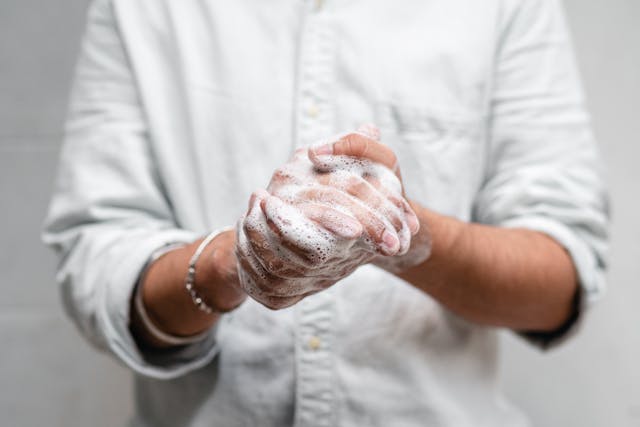
Soap or hand sanitizer? Soap removes germs and bacteria by killing and then washing them away, while hand sanitizer kills them. Soap and hand sanitizer deal with bacteria and things like that in different ways. One of them is more successful than the other. Let’s have a look at them both.
How does soap remove germs and bacteria from your hands? The first thing to be aware of is that soap doesn’t just kill bacteria and germs. Bacteria, viruses, and other germs stick to our skin until we either wipe them off on something, or put them into our mouths. We touch our face and mouths far more often in a day than we think we do. Soap works by attaching to the bacteria and germs so that they can be washed off. Soap molecules have two ends. They have a hydrophobic end, which hates water, and a hydrophilic end, which loves water. The hydrophilic end is happy floating around in the water we use when we wash our hands, but the hydrophobic end wants to get out of the way. If you have oil or fat on your hands, the hydrophobic end will happily attach to the oils and fats to get away from the water. Then, when you rinse the soap off, it carries the oil and fat with it. Most bacteria and viruses have a lipid membrane around them. This lipid membrane contains all of the proteins that viruses use to infect cells and many of the proteins that the bacteria use to function. A lipid is a fat, and the hydrophobic end of the soap molecule is desperately looking for fats. When a soap molecule comes into contact with a virus or a bacteria, it attaches to the lipid layer and pulls on it. It pulls so hard, that the layer ruptures and all of the necessary proteins spill out and the virus or bacteria dies, or is incapacitated. The soap doesn’t kill all of the germs and bacteria, but it does remove the majority of them. When the soap molecules surround the bacteria, they attach very strongly with their hydrophobic end and they attach very strongly to the water with their hydrophilic end. When you rinse the soap off, this connection is stronger than the connection holding the bacteria to your hand. Washing your hands with soap also has another consequence. It does that because you don’t just put soap on your hands and then wash it off, at least you shouldn’t. You put soap on your hands, and then vigorously rub them together. That friction pulls off a lot of the pathogens, which then get washed off when you rinse your hands. Scrubbing your hands for 15 seconds removes 90% of germs and 30 seconds removes 99.9%. Singing happy birthday twice is supposed to give you just the right amount of time.
How do hand sanitizers work? Most hand sanitizers contain alcohol and that is what kills the bacteria and virus. It attacks the same lipid layer that soap breaks. The lipid layers are held together by hydrogen bonds and alcohol can disrupt those bonds. That dissolves the membrane and all of the vital proteins spill out again, killing the pathogen. That sounds better than soap, but it actually isn’t. Soap can remove pathogens even if it doesn’t kill them first. Hand sanitizers can’t do that. If the alcohol doesn’t kill the bacteria, then they will stay on your hand. That is very likely if you don’t use enough sanitizer, or if you wipe it off too quickly. There are also a lot more bacteria and viruses that are becoming resistant to alcohol. They can mutate so that the alcohol doesn’t break apart their lipid layer, or some have evolved biofilms which cover them and protect them. The more people that use hand sanitizers exclusively, the more mutated bacteria and viruses we will see. It takes stronger and stronger alcohol concentrations to kill these bacteria, and that is dangerous. Also, it won’t be long before the bacteria are resistant to stronger alcohol as well. Another problem is that putting a lot of alcohol on your hands dries them out. Most hand sanitizers have to contain some chemicals that form a gel that protects the hands from the effects of the alcohol. Without this, the alcohol would dry out your skin and cause a lot of pain and discomfort. Washing your hands with soap and water is always best. And this is what I learned today.
Sources
https://www.ucihealth.org/blog/2020/04/soap-vs-sanitizer
https://www.meritech.com/blog/how-soap-works
https://medicine.yale.edu/news-article/why-soap-works
https://cen.acs.org/business/consumer-products/hand-sanitizer-does-keep-hands/98/i12
Photo by Ketut Subiyanto: https://www.pexels.com/photo/person-washing-hands-4308205/
